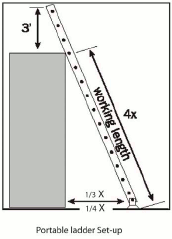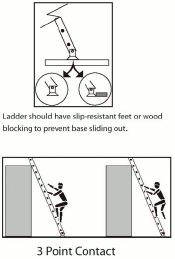b. Set-up
All portable ladders must be set-up the following way:
- locate ladder on a firm footing and
make sure slip resistant feet are
adequate or tie top/bottom of ladder
off or use wood blocking or have
someone hold the ladder
- place feet 1/4 to 1/3 of ladder's
working length out from the base
- rest both ladder rails on the top
bearing point - do not use the ladder
rungs to support the top of the ladder
- extend ladder 1m (3') past the point
of bearing
c. Safe Use
- inspect all ladders before using
- select the right ladder for the
job:
- use non-conductive ladders
when working near
energized equipment or
electrical circuits
- set up barricades and warning
signs when ladders are set-up
in doorways or passageways or
any other location where
the ladder could be struck
- get help when setting up a long
or heavy ladder
- only one person should be on a ladder at a time
- face the ladder when going up or down
- use three point contact when climbing
- keep the centre of the body between the ladder rails
- clean muddy/slippery boot soles before getting on a ladder
- do not carry objects while on a ladder - hoist materials and attach tools to a belt or pouch
- do not step on the top two rungs of any ladder


